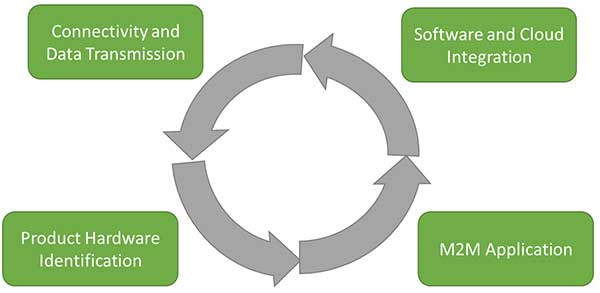IoT product development life cycle
The Internet of Things (IoT), after years of speculation, is starting to take off. In the last five years alone, businesses and products that use IoT technologies has nearly doubled to 25%. It is estimated that there will be over 73 billion connected devices by 2025. It’s also estimated that nearly two-thirds of enterprise companies will adopt IoT to help reduce expenses, optimise assets, and improve internal safety and security.
Building products in this new era of connected devices requires a strategic and focused product development cycle. The IoT product development cycle is divided into thinking, planning, and building new smart product plans.

Fig 1: IoT hardware platform
Regarding our product development strategy, we discuss the following:
Goal
Begin by understanding your desired goal from this phase. You’ll want to come away with a succinct product vision, a technical product architecture, at least one physical design concept, pricing estimates for production, and a detailed product development plan.
Initial Study
Review marketing research, similar products, user needs, timeline, and team to prepare a feasibility report to provide direction and technical strategy for product development. This is an important first step because it’s the beginning of turning your idea into a tangible product. As much as it can be the stepping stone to the next step, this can also prevent you from heading down the wrong and potentially costly & time-consuming paths.
Technical Architecture
Create a mechanical, electrical, firmware, cloud, mobile, and database architecture that best meets the market needs, usage factors, and constraints for the product. This step is a common stumbling block for new IoT initiatives. Because this step uncovers the tech stack needed to realise the product. It can be technically nuanced and involve multidisciplinary teams, all increasing the complications behind a project.
Prototypes
Development of a rapid prototype, generally using off-the-shelf hardware and software, to shed light on the key 'gating' questions around technology, features, user interface, and unit cost. From looks-like to alpha prototypes, this is when some of the biggest unknowns show in a product. Low-fidelity, quick turnaround prototypes allow a potential pitfall to present itself sooner than later, which could financially save a project entirely.
Product Requirements Document
Create a preliminary product requirements document (PRD) that clearly describes the appearance, usability, function, and functionality of your product. This document provides templates to guide product development throughout the process.
There are several considerations to keep in mind when developing smarter and more mature IoT products. IoT devices must include fast and secure connectivity, advanced data management, and robust device management. Monitoring is essential to keep your products up and running. Appropriate test cases for each feature reviewed and approved by all key stakeholders in the product team are used to ensure that all core requirements are intact and consistent with the final product.
IoT Development Requirements
The IoT development stack has five layers to create a complete IoT solution.
IoT hardware device
It is the first layer in the IoT technology stack, which defines the digital and physical parts of any smartly connected product. In this stacked layer, it is necessary to understand the size, implementation, cost, life, reliability, etc. If we are talking about small devices such as smart watches, you may only have one space for such a system-on-chip (SoC). Here, you will need a built-in computer such as Raspberry-Pi, BeagleBone board and Artik module.
Device software
At this level, you need to identify the sensors that can access the data you need. These sensors help collect the data needed for connected smart products to function as intended. Device software can transform device hardware into smart devices. This set of IoT technologies allows you to define devices in software, allowing each device to provide different applications depending on the software it is running.
Connectivity
In the IoT communication suite, it is important to connect the device and sensors to the cloud and then decide which network communication platform to connect to the application. The most common connection types are Bluetooth, Wi-Fi, radio, cellular, and satellite. The communication section of this step describes several ways to exchange information about your device with the world. This includes the type of physical network and protocol being used.
IoT Product development stages
The stages or steps involved in an IoT-product development are depicted in the image given below. 
Data transmission and connectivity
A team of experienced and renowned IoT engineers can add secure wireless control and connectivity to mobile phones, Wi-Fi, RFID, GPS, Bluetooth and other types of products. A top priority for IoT product development teams is to transmit data in real time without sacrificing security or privacy.
Hardware Identification
Product hardware identification is one of the most important parts of IoT product development. Amongst these, two types of equipment are required for IoT product development. One is a sensor element and the other is the conversion of an electrical signal into a physical result. With the in-depth knowledge of various sensors and devices, great success can be achieved in developing IoT products. A few sensors are temperature sensor, smoke sensor, pressure sensor, gyroscope, etc.
M2M Application
The M2M application has two machines that communicate or exchange data without any human interaction. This includes the connection of power lines, the serial connection and the wireless communication in the IIoT.
Software and Cloud integration
Amongst all the IoT product development stages, software and cloud integration are other important stages for building the best IoT product. The development team is responsible for building web and mobile-based applications for controlling the functionality of products in real-time. There is a custom software application that is hosted on the cloud servers to manage controlling, monitoring, optimising, and autonomous operation of product function. Some of the cloud services are Google cloud, Azure IoT Hub, Aws IoT, etc.






